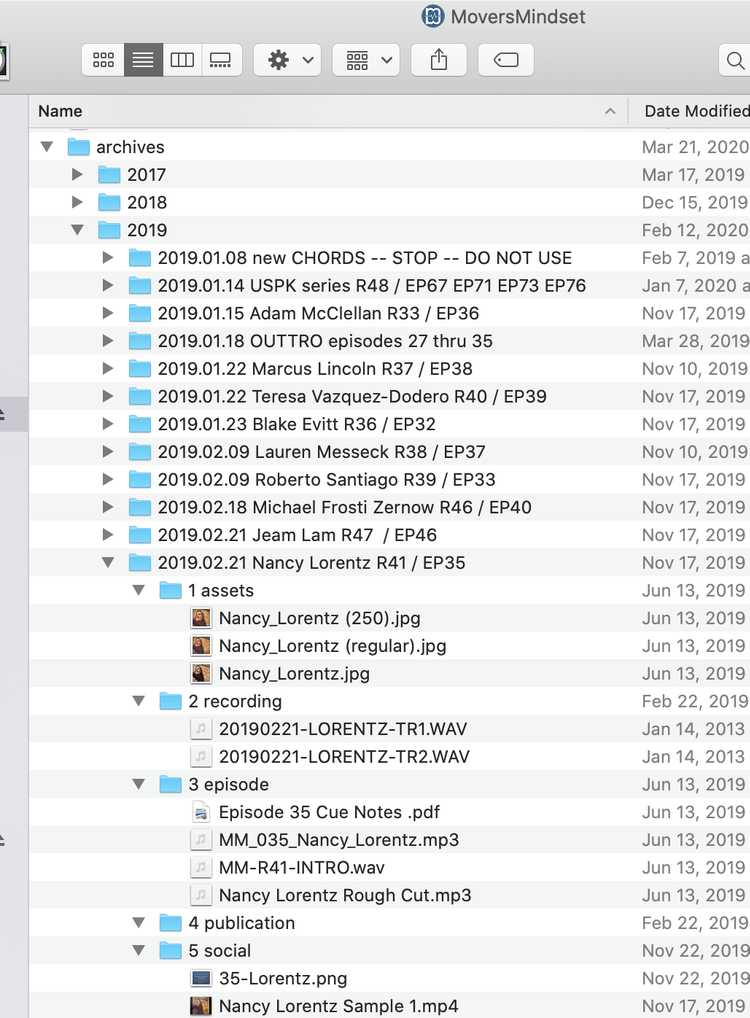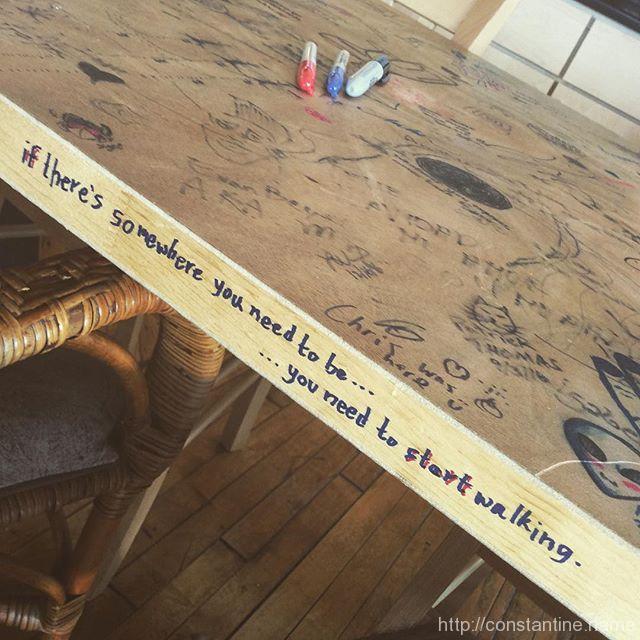Passion makes us feel, but never see clearly.
~ Bulwer-Lytton
slip:4a1546.
Passion makes us feel, but never see clearly.
~ Bulwer-Lytton
slip:4a1546.
If there’s somewhere I need to be, I need to start walking. It’s insightful, but it begs a few questions. Do I really understand “where” I need to be (that is to say, what does the word “where” really stand for if I’m to use the proverb)? Is there a path from “here” to “there”? And really sticky question: Are there any true obstacles, like gates with gatekeepers, between “here” and “there”?
The world is full of gatekeepers who think they have veto rights. Don’t believe them. If you need them to invest time or resources then they deserve to have a say, otherwise the responsibility remains with you to decide how to proceed and to suffer the consequences or reap the rewards, as the case may be.
~ Andrew Bosworth from, Ask for Advice, Not Permission
slip:4uboai2.
There are many ways (metaphorical and literal) to go over, under, around and through gates and gatekeepers. I’ve always visualized the proverbial gatekeeper as part of a structure surrounding something, keeping me out. But why that orientation?
Recall Douglas Adam’s Hitchhiker’s Guide wherein one character builds an asylum for the world; A “house” with the “interior” stuff (carpet, furniture, lights, curtains, etc) on the outside, exposed to the elements, and with a central space with no roof, faced with the exterior parts of a home. In that center was “outside” the asylum and the entire rest of the world was therefore “inside” the asylum thus constructed.
Why aren’t the gatekeepers seen as denying us access to exit? I don’t want “in” to gain access to some resource or some people. I want “out” to regain my freedom.
ɕ
The essence of restorative community building is not economic prosperity or the political discourse or the capacity of leadership; it is citizens’ willingness to own up to their contribution or agency in the current conditions, to be humble, to choose accountability, and to have faith in their own capacity to make authentic promises to create the alternative future.
~ Peter Block
slip:4a1190.
An evil-speaker differs from an evil-doer only in the want of opportunity.
~ Quintilian
slip:4a929.
If we play our cards right, we could live hundreds of thousands of years more. In fact, there’s not much stopping us living millions of years. The typical species lives about a million years. Our 200,000 years so far would put us about in our adolescence, just old enough to be getting ourselves in trouble, but not wise enough to have thought through how we should act.
~ Toby Ord from, We Have the Power to Destroy Ourselves Without the Wisdom to Ensure That We Don’t | Edge.org
slip:4ueeco4.
I find it beneficial to have my perspectives stretched. This article walks through scales of time in a delightful manner. It pauses to ask questions, and to point out people who did certain things at precise points in our history. There are countless opportunities to shift perspective. For example: I’ve been alive for 1/100 of recorded human history. And recorded history is only 3/100 of the age of our species. The aggregate progress of humanity is simply the sum of our individual efforts, and my life represents 1/100,000,000,000 of humanity so far. Stretched perspectives indeed.
ɕ
The existence of evil does not harm the world. And an individual act of evil does not harm the victim. Only one person is harmed by it—and he can stop being harmed as soon as he decides to.
~ Marcus Aurelius
slip:4a500.
Within the team that creates the Movers Mindset podcast, we assign numbers to our projects. We use “R42” for our 42nd recording project, then R43, and so on. This enables us to start naming things from day one, in a way that we don’t have to change later. If you’re putting your files in a folder, what would you name it, that you could be sure wouldn’t change?
We also use our podcast’s initials on file names, “MM.” When we see files whose name contains, MM-R42… we know what it belongs too. It’s part of the Recording-42 project for Movers Mindset.
We also exclusively use people’s family names on files. So a raw WAV file from an interview is 20200423-MM-SMITH-TR1.wav … April 23, 2020 recording for Movers Mindset, of someone named “Smith”, and this is track one [a recording from one microphone.] 20200423-MM-SMITH-TR2.wav is track two, and so on. No matter where you toss that file, it’s going to make sense.
Eventually, a recording project might lead to one (or more!) episodes of our podcast. They get assigned episode numbers, EP56, EP57, etc. Then we have filenames like MM-EP57… and it’s always clear what that is.
Sometimes we have a dozen files to keep track of in a podcast episode and we end up with20200423-MM-SMITH-TR1.wav20200423-MM-SMITH-TR2.wavMM-EP56-INTRO.wav (introduction recorded after interview)MM-EP56-OUTRO.wav (outro recorded in post production)MM-GCORD.wav (a little music ‘button’ used when joining bits of interview)
…the final episode is then MM-EP56-SMITH.mp3
Since I’ve typed this much, here’s another thing we do: We use consistently numbered folders to store the files. Every project has a folder, 2020.04.23 Bob Smith R42/EP56 — we create 2020.04.23 Bob Smith R42 in our archives when we do the raw recording, and at the very end we add the /EP56 to make it easier to find things. In side each project we create five folders 1 assets, 2 recording, 3 episode, 4 publication, and 5 social — the leading number ensure they sort in nice order in various displays. 1 contains anything the guest gives us (photos, writing) or any photos we take during recording. 2 is the raw original recordings, 3 is everything to make a podcast episode (intro, outro, whatever we have to assemble, AND the finished MP3), 4 is anything we create as part of publishing the episode (transcript, articles, highlights ) and 5 is anything that’s ok for social media and sharing. And then we have a multi-terabyte file server with a “few” files on it:

ɕ
It is not so much what you are doing as how you are doing it. When we properly understand and live by this principle, while difficulties will arise—for they are part of the divine order too—inner peace will still be possible.
~ Epictetus
slip:4a167.
Wow.
It took me years longer than I had originally hoped to finish this series of posts. I’ve recently decided to push these posts out the door so that they could possibly be of some use to others. Having them laying around as drafts-in-progress isn’t helpful.
As this series was being written, I took a terrific detour working with two friends who were experimenting with starting their own personal training company. They used me as a guinea pig for testing their coaching and training systems for nutrition, psychology of eating and physical training. During this time working with them I succeeded at some huge improvements in psychology (related to eating) and achieved the best physical condition I’ve been in in recorded history. If you want to do a deep dive, check out, Training for the New Alpinism.
…and a few other disjointed thoughts:
This: From Nerd Fitness, 5 Steps After Failing.
slip:4unebo4.
What do I want? I simply want to be able to move and play. I’m constrained by physical limitations (age, body type, etc.), but mostly just by my total weight. So although I always want to increase my general fitness, the current first order problem—and I’ve linked directly into the Wikipedia article to the section that could be a profound, new way for you to consider when solving problems—for me is simply weight. For me, that is almost entirely driven by psychology—psychosis?—as it applies to food.
What am I tracking? I’ve often heard, “that which you measure gets improved.” Tracking and measuring does focus your attention, but it only gets you data. You have to be motivated to analyze that data and make adjustments to your routine. Am I making progress? Is the rate of progress what I expected when I planned? Is the progress too slow or too fast? What can I change that would affect the progress? What happens if I cycle periods of tracking a lot, and tracking nothing? You have to look at your assumptions, analyze, research, and experiment to figure out what’s true. “Science, bitch!” ~ Jesse.
So long, and thanks for reading!
ɕ
What role does fear, physical limitations, and personal motivation play in pursuing movement-based activities as one ages?
Jean Lam reflects on how she became interested in fitness and eventually joined the industry, her love of movement, and what sports and activities she is involved in now. Jean discusses corrective exercise, and shares her insights on programming, motivation, and scope of practice. She goes into injury and rehab, before explaining how she keeps up with coaching best practices.
I think that failure is part of the equation. If everything you do guarantees success, you’re not going to ever expand and do more.
~ Jean Lam (14:20)
Jean Lam discusses her journey from being a self-described couch potato to becoming deeply involved in movement-based activities such as parkour, skiing, and aerial silks. She shares how discovering jazzercise in her twenties helped her lose weight and sustain her fitness for over 30 years. Jean emphasizes the importance of finding joy in physical activities and explains how parkour became a fun and functional way to apply the strength she built through traditional gym workouts. She reflects on how women can be inspired by seeing others engage in movement and how visibility plays a role in motivating participation.
Jean delves into the psychological aspects of fear and adrenaline in sports, contrasting her controlled approach with the more extreme pursuits of others. She highlights her involvement with PK Silver, a program designed to teach older adults parkour-inspired movement. Jean discusses the importance of addressing physical dysfunctions through corrective exercise, focusing on mobility and prehab. She stresses the need for fitness professionals to stay within their scope of practice and explains how she continuously educates herself to provide safe, science-based programming for clients.
Takeaways
Fear as a limiting factor — Addressing fear helps expand comfort zones and prevent further restriction of movement.
The role of fun in fitness — Enjoyable activities sustain long-term engagement with physical exercise.
Corrective exercise — Addressing physical dysfunctions is essential for safe and effective movement, especially as the body ages.
Scope of practice — Fitness professionals must recognize boundaries between training and medical treatment to avoid harm.
Motivation through community — Seeing others engage in movement inspires peers to take action and pursue their own fitness goals.
Aging and movement — Fitness routines should adapt to the needs of older adults by incorporating mobility and stability exercises.
Overcoming injuries — Recovery from acute injuries involves patience and may change how training is approached.
PK Silver programming — Teaching older adults movement-based skills involves addressing confidence, fear, and functional limitations.
Progression and adaptability — Programming for clients should evolve based on their capabilities, ensuring movements match their current physical state.
Physical limitations and self-awareness — Understanding personal limitations helps prevent injury and supports sustainable fitness progress.
Resources
PK Move — A non-profit dedicated to teaching parkour to all ages, including the PK Silver program for older adults.
Conversation with Fear — Mermer Blakeslee’s book exploring the psychology of fear and strategies for confronting it in sports and life.
Barbell Physio — A resource for strength and mobility training, founded by a physical therapist with a focus on functional movement.
Shift Movement Science — Provides educational resources on gymnastics and physical therapy for athletes.
National Academy of Sports Medicine (NASM) — Organization offering certifications in corrective exercise and fitness specializations.
(Written with help from Chat-GPT.)
ɕ
Truth be told, if I really wanted to help people lose weight I would increase the price of Eat Stop Eat to 100 dollars per book. Far less people would buy it, but those who did would be invested heavily in making a change in their lives. They wouldn’t just read about fasting and weight training, they’d actually practice it.
~ Brad Pilon from, What Do You Do When A Friend Asks You For Advice On Losing Weight? – Brad Pilon’s ‘Eat Blog Eat’
slip:4ubawe1.
Call it wisdom– Call it Imposter Syndrome— whatever. The more I learn about health, the more I’m convinced I know nothing.
For me, the solution to my unhealth was to change my life. Not, “more exercise,” but “rediscover moving.” Not, “eat better,” but “listen honestly to my body.” Not, “lose weight.” — there’s no, “but…” on that last one; The weight loss just happens the more I change my life.
ɕ

A proper croissant?! Don’t mind if I do.
ɕ

This morning’s contribution to the table at Chez Anton. Hugely inspiring weekend at #ardv17 !
ɕ

But first, a nap on a gooooorgeous day.
ɕ
One of the insidious things about the distraction habit is that we often don’t even realize it’s happening. It sneaks up on us, like old age, and before we know it we’re addicted and powerless.
But actually we’re not powerless. The power we have is our awareness, and you can develop it right now. Pay attention to what sites you visit, how often you’re looking at your phone, how long you’re spending in front of a screen all day.
~ Leo Babauta from, An Addict’s Guide to Overcoming the Distraction Habit – Zen Habits Website
slip:4uzedi1.
ɕ

Wassup? Catchin’ a train to Boston…
ɕ
Self-perception theory says you observe your own behavior and then, after the fact, make up a story to explain it. That story is sometimes close to the truth, and sometimes it is just something nice that makes you feel better about being a person.
~ David McRaney from, The Overjustification Effect – You Are Not So Smart
slip:4uyote1.
ɕ

…beginning to look like a kitchen again.
ɕ